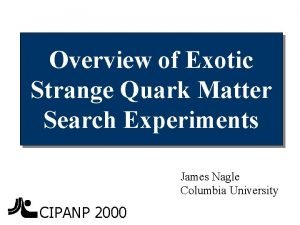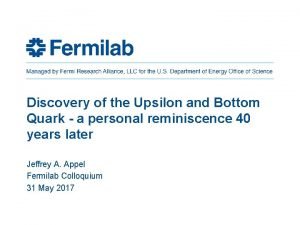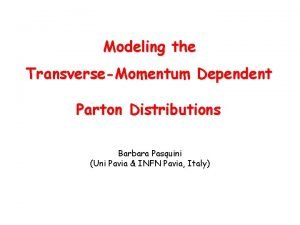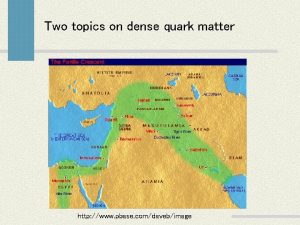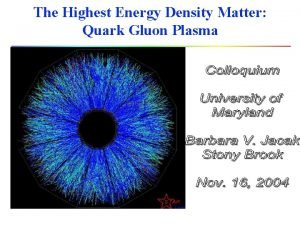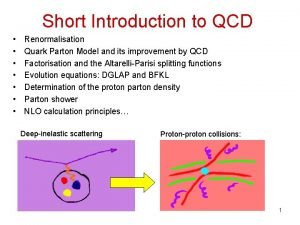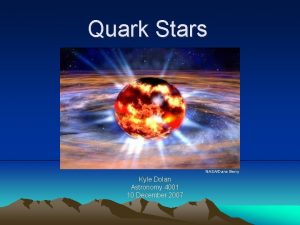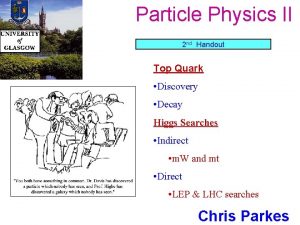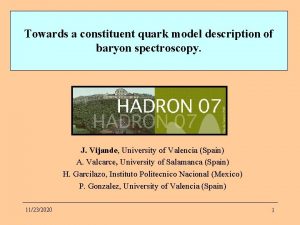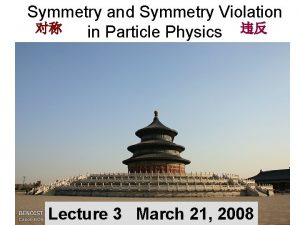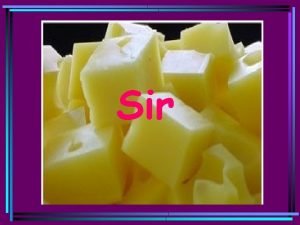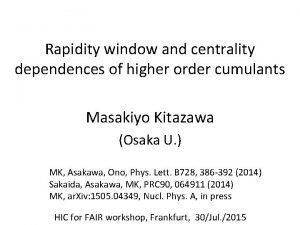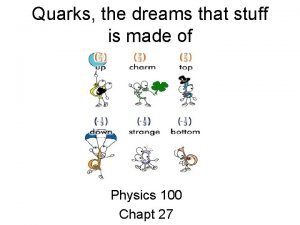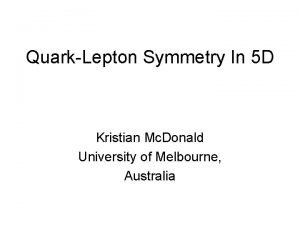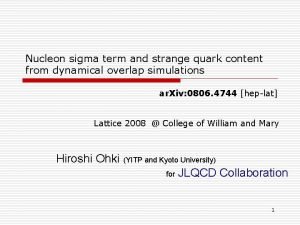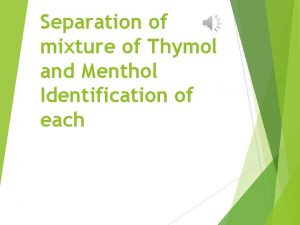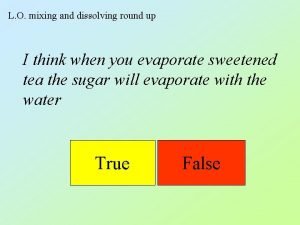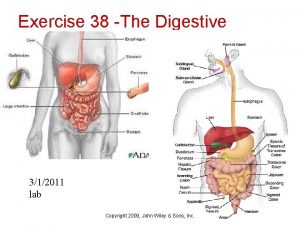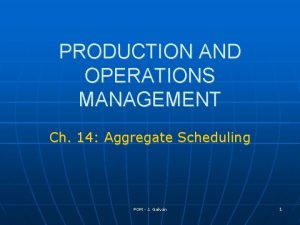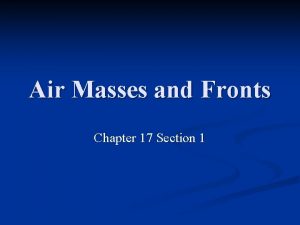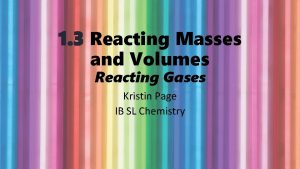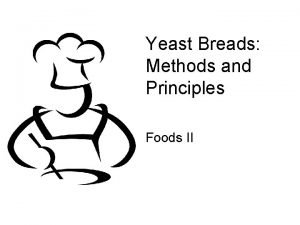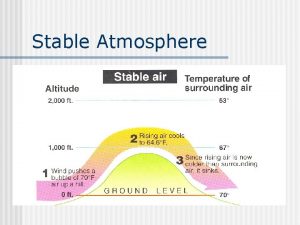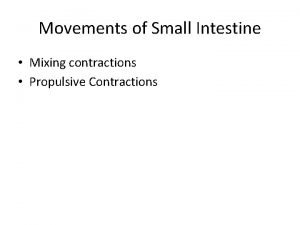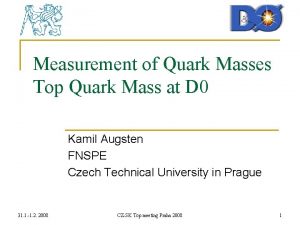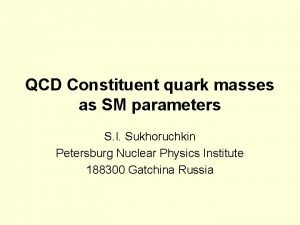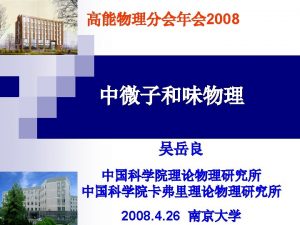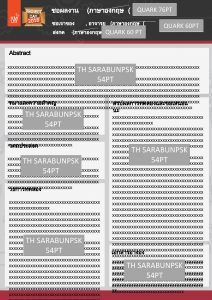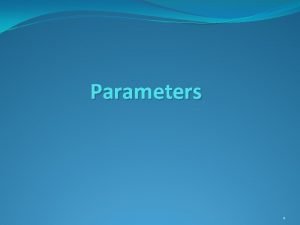Quark masses and quark mixing parameters whats next















































- Slides: 47

Quark masses and quark mixing parameters – what’s next? Marina Artuso Syracuse University July 3 rd, 2001 Marina Artuso Snowmass 2001 1

The questions • What are the values of the quark masses and quark mixing parameters? • Are they consistent with the Standard Model? • Within “beyond SM” theory, additional parameters may be pinned down by analyses geared towards CKM determination July 3 rd, 2001 Marina Artuso Snowmass 2001 2

Quark Masses • This is a good illustration of the interplay between fundamental parameters and QCD. • QCD effects increase as quark mass becomes closer to QCD scale Lqcd 0. 5 Ge. V. • Theoretical tools: • Lattice • HQET • Chiral perturbation theory July 3 rd, 2001 Marina Artuso Snowmass 2001 3

A pocket guide to quark masses Approximate values (Ge. V/c 2) Mass hierarchy is a striking feature July 3 rd, 2001 Marina Artuso Snowmass 2001 4

The heaviest of all: mt CDF & D 0 combined results July 3 rd, 2001 Marina Artuso Snowmass 2001 5

Is the top quark special? • mt scale of the EW symmetry breaking: • SUSY: large Yukawa coupling at Planck scale lt (mt ) 1 • Higgs a tt bound state? (Bardeen, Hill & Lindner) • Te. V II should bring error in mass determination down to 2 Ge. V! July 3 rd, 2001 Marina Artuso Snowmass 2001 6

mb and mc • Non perturbative effects are important. • Quark masses are “running”: important to define the scale at which they are evaluated. – Pole mass ill defined – “short distance masses” (potential subtracted, kinetic mass…) – mq(m) July 3 rd, 2001 Marina Artuso Snowmass 2001 7

Theory input on mb (sample of a vast literature) Important for Vc(u)b expansion, semileptonic decay moments Jet observables sensitive to b mass(LEP) July 3 rd, 2001 Marina Artuso Snowmass 2001 8

mc • Charmonium data (moments) mc= 1. 35 0. 05 Ge. V • HQE (short distance definition): July 3 rd, 2001 Marina Artuso Snowmass 2001 9

Quark Mixing • Weak interaction couples weak eigenstates, not mass eigenstates: CKM matrix relates these two representations: weak eigenstates VCKM mass eigenstates CKM unitary described by 4 parameters (3 real, 1 imaginary) July 3 rd, 2001 Marina Artuso Snowmass 2001 10

The CKM matrix in the Wolfenstein parameterization d s b u c t • Good l 3 in real part & l 5 in imaginary part • We know l=0. 22, A~0. 8; we have constraints on r & h strategy to pin them down under way July 3 rd, 2001 Marina Artuso Snowmass 2001 11

The Unitarity Triangles • “ds” - indicates rows or columns used • There are 4 independent parameters, which can be used to construct the entire CKM July 3 rd, 2001 Marina Artuso Snowmass 2001 12

- measured CKM magnitudes: present data ud: -decay 0. 9739 0. 0009 us: K e 0. 2200 0. 0025 - assuming unitarity ub: b ul &B ( )l 0. 0035 0. 001 cd: d lc ll. X 0. 224 0. 016 cs: D Ke , W Xc X 0. 97 0. 11 cb: b cl , B Dl 0. 041 0. 003 td: Bd mixing 0. 0083 0. 0016 ts: Bs mixing 0. 04 0. 01 tb: t bl 0. 99 0. 15 July 3 rd, 2001 Marina Artuso Snowmass 2001 13

In other words: • We now know the Wolfenstein parameters: – A~0. 8 – l= 0. 22 • We are working hard to over-constrain the r -h plane: – Precision determination of Standard Model parameters? – ‘Beyond the Standard Model’ effects – Check validity of ‘new physics’ effective theories July 3 rd, 2001 Marina Artuso Snowmass 2001 14

A map of the ‘quark mixing’ hunt • Improvements on the measurements of the sides will be achieved through the interplay between new precision data available and refinements of theoretical tools • The angles a, b, g will be determined studying 2 -body hadronic B-decays (rare): B pp, Kp, rp, DK , y. K • Help from (rare) K p after 2005 July 3 rd, 2001 Marina Artuso Snowmass 2001 15

Experimental input • The goal: – measure all the masses and mixing parameters to challenge the Standard Model and find clues towards a more complete theory • The challenge: – QCD is the obstacle that nature has put on our “treasure hunt” of these fundamental parameters. We need a better understanding of hadronic matrix elements to complete our program July 3 rd, 2001 Marina Artuso Snowmass 2001 16

Experimental constraints • Experimental information: – semileptonic decays of heavy flavored hadrons – m in flavor oscillation of the B(d, s) mesons – CP violation observables in B decays (starting now) – CP violation observables in K decays – Rare K decays • The challenge: extract the fundamental parameters from data (we observe hadrons, not quarks!) July 3 rd, 2001 Marina Artuso Snowmass 2001 17

Theory input • HQET effective theory is valid when mq – applications to exclusive decays. • Heavy Quark Expansion – application to inclusive properties (decay widths, totalsemileptonic-moments of inclusive properties) • Lattice Gauge Theory, based on QCD but still on its way to precise calculations (although may be very close, more later. . ): the first theory to have both statistical and systematic errors! July 3 rd, 2001 Marina Artuso Snowmass 2001 18

Vcb from B D*l • HQET: • The shape, not a clearly predictable quantity, but is constrained by theoretical bounds and measured form factors July 3 rd, 2001 Marina Artuso Snowmass 2001 19

The parameter FD*(1) – Lim FD*(1) = 1 as mb , – FD*(1)=1+O(as/p)+d 1/m 2+d 1/m 3 (no d 1/m , Luke’s theorem) – FD*(1) = 0. 91± 0. 042, from Caprini, Uraltsev…. . – FD*(1) = 0. 89± 0. 06, from Bigi (June 1999) – Lattice QCD calculation is an important check. • Jim Simone’s talk @ Lattice 99 FD*(1) = 0. 935 ± 0. 035, some errors not yet evaluated (quenching, cutoff) – What is the meaning of theoretical errors? July 3 rd, 2001 Marina Artuso Snowmass 2001 20

|Vcb| from B D*l • • Study w: w(CLEO)= 0. 03; w(LEP) 0. 07 Fit each w-bin for (B D*l +D*Xl +bgds) CLEO limit: (slow ) F(1)|Vcb| LEP limit: D*Xl level • Model of Leibovich, et al. PRD 57, 308 (1997) • CLEO measures it, sees less Extrapolation CLEO 2001 F(1)|Vcb|=(42. 2 1. 3 1. 8) 10 -3 2=1. 61 0. 09 July 3 rd, 2001 CLEO D*+l , D*0 l 5%Artuso total error Marina Snowmass 2001 on F(1)|Vcb| 21

Vcb Exclusive Averages CLEO fits both a smaller D*Xln AND a larger 2 than LEP, & both are correlated with FD*(1)|Vcb| When taking out F(1), • LEP WG uses F(1)=0. 88 0. 05 • CLEO uses F(1)=0. 913 0. 042 l CLEO 42. 2 1. 3 1. 8 7% CL consistency July 3 rd, 2001 Marina Artuso Snowmass 2001 22

|Vcb| from inclusive B Xcl • From B(B Xcl ) extract the experimental decay width: • Compare with theoretical prediction from Operator Product Expansion: July 3 rd, 2001 Known phase space factors Marina Artuso Snowmass 2001 23

Another parameterization of inclusive semileptonic decays • Using Operator Product Expansion & Heavy Quark Expansion, in terms of as(mb), L, and the matrix elements l 1 and l 2 • These quantities arises from the differences • From B*-B mass difference, l 2 = 0. 12 Ge. V 2 • July 3 rd, 2001 Marina Artuso Snowmass 2001 24

, 1 • determined from “Moments” Prediction on , 1 from Lattice QCD (Kronfeld & Simone, hep-ph/0006345. ) • , 1 determined from A. Falk, M. Luke, & M. Savage, PRD 53 (2491) 1996. M. Gremm & A. Kapustin, PRD 55 (6934) 1997. M. Voloshin, PRD 51 (4934) 1995. 1. Measured hadronic spectral moments in b cl 2. Measured photon energy spectrum moments in b s 3. Measured lepton energy moments in b cl • New, preliminary CLEO data on 1, 2 (3 close to be ready too). July 3 rd, 2001 Marina Artuso Snowmass 2001 25

CLEO b sg spectral moments • Measure photon spectrum in lab-frame. • Convert to B rest frame. MC accounts for smearing – Best match mb= 4719± 115 Me. V/c 2; p. F = 378± 150 Me. V • Extract moments (Eg > 2. 0 Ge. V) E =2. 345 0. 030 0. 010 Ge. V (1. 3%) July 3 rd, 2001 Marina Artuso Snowmass 2001 26

B Xc ln Hadronic Mass Moments • Lepton (p>1. 5 Ge. V) • -reconstruction: p • Calculate recoil mass • Fit spectrum w/B Dln, B D*ln, B XHln (various models for XH) • MX 2 - MD 2 , MD is spinaveraged D, D* mass DATA Fit D*l Dl XHl MX 2 - MD 2 MX 2 -MD 2 = 0. 287 0. 065 Ge. V 2 Second moments give consistent nd 4 • 2 moment: 0. 63 0. 17 Ge. V results, but still theoretically shaky. July 3 rd, 2001 Marina Artuso Snowmass 2001 27

CLEO Vcb from b cl , b s • Using – B(B Xc l )=(10. 39 0. 46)% (CLEO, PRL 76 (1570) 1996 ) – = (1. 548 0. 032) psec (PDG) – 0 = (1. 653 0. 028) psec (PDG) – f+-/f 00 = 1. 04 0. 08 (CLEO, hep-ex/0006002) • (b cl ) = ( 0. 427 0. 020 ) 10 -10 Me. V • |Vcb|= (40. 5 0. 9 0. 8) 10 -3 exp July 3 rd, 2001 3 1/M ( , l 1 )exp B 3. 7% total error Marina Artuso Snowmass 2001 28

, l 1 from b sg, B Xcln moments July 3 rd, 2001 Marina Artuso Snowmass 2001 29

A note of caution CLEO • Discrepancy between hadronic mass moments and El moments • Taking Mx estimates only: – L MB-mb(POLE)= 0. 33 0. 02 0. 08 Ge. V mb=4. 97 0. 10 Ge. V – l 1=-0. 13 0. 01 0. 06 Ge. V 2 July 3 rd, 2001 Marina Artuso Snowmass 2001 30

Inclusive b cl LEP CLEO Vcb Incl 41 2 2 5%? common theoretical error July 3 rd, 2001 Marina Artuso Snowmass 2001 31

|Vcb| Summary F(1)=0. 88 F(1)=0. 913 CLEO Exclusive CLEO Inclusive CLEO Moments 2001 Prel. 46. 4 2. 1 41 2 2 40. 5 1. 3 0. 8 LEP Incl+Excl Avg Combine at your peril July 3 rd, 2001 Marina Artuso Snowmass 2001 32

b ul • Similar to b cl BUT BR(b uln ) ~ 2 10 -3 ! • Experimentally: few evts, swamped w/ b cl • LEP expmts use inclusive analysis – – LEP |Vub| avg has 10% statistical error HQE uncertainty (5%) + duality/modeling unc. (12%) Systematics from identifying & separating b u, b c Systematics from non-b u, non-b c suppression • CLEO uses “ -recon. ” for B l , l – Statistical error of 4% – Form-factor model uncertainty of 17% July 3 rd, 2001 Marina Artuso Snowmass 2001 33

|Vub| from LEP using hadronic mass cut • Analyses of ALEPH, DELPHI & L 3 • Look for b u l • Use likelihood that hadron tracks come from b decay: vertex info, pt…. • Eliminate identified kaons (DELPHI only) • Mass < MD b u some assumption on M needed u July 3 rd, 2001 Marina Artuso Snowmass 2001 34

Vub from pl and rl p+l + p 0 l CLEO b u backrounds & cross-feeds r+l + r 0 l + wol July 3 rd, 2001 b c backrounds b u backrounds & cross-feeds Marina Artuso Snowmass 2001 35

Bd Mixing: md Measured in two ways: - method: tintegrated B 0 B 0 vs B 0 B 0; e. g. dileptons - direct, t-dependent observation of B 0 oscillations by flavor tagging as a fcn of decay lengths 2% error LEP Group July 3 rd, Working 2001 /3 md. Marina (ps-1 Artuso ) m d Snowmass 2001 B 36

Bs Mixing • Bs too heavy to be produced @ (4 S) – LEP, SLC, Tevatron • Near maximal mixing observed – ms unlike Bd – Oscillations not yet definitively seen due to large frequency; hard to measure – Only get lower limit on ms, even when combining all expmts July 3 rd, 2001 Marina Artuso Snowmass 2001 37

ms World Average LEP B Oscillations Working Group 1 1. 645 Sensitivity to exclude Amplitude=0 @95%CL at 18. 1 ps-1 1. 645 (stat only) Yes oscillation No oscillation ms >15 ps-1 Amplitude=1 excluded @95%CL up to 15 ps-1 July 3 rd, 2001 Oscillation frequency Marina Artuso Snowmass 2001 38

sin 2 • • • 0. 34 0. 21 0. 58 0. 34 0. 79 0. 43 0. 84 0. 93 3. 2 2. 0 Ba. Bar Belle CDF ALEPH OPAL • World Average: 0. 48 0. 16 July 3 rd, 2001 Marina Artuso Snowmass 2001 39

sin 2 • • • 0. 34 0. 21 0. 58 0. 34 0. 79 0. 43 0. 84 0. 93 3. 2 2. 0 Ba. Bar Belle CDF ALEPH OPAL • World Average: 0. 48 0. 16 July 3 rd, 2001 Marina Artuso Snowmass 2001 40

“ 95% CL” w/sin 2 Constraint From A. Hocker, et al. hep-ph/0104062 July 3 rd, 2001 Marina Artuso Snowmass 2001 41

A road map to progress • milestones in the experimental program – large data sets accumulated at e+e- b-factories and Tevatron – large data sets accumulated at dedicated bexperiments at hadron colliders (BTe. V-LHCb) – results from rare K decays • Milestones in theoretical program: – Precision unquenched lattice gauge calculations available – Further checks/refinements in HQE/HQET July 3 rd, 2001 Marina Artuso Snowmass 2001 42

Milestone I ( end of pre-LHC era) • e+e- b-factories will have a few hundred fb-1 data sets – sin 2 error down to 0. 05 (500 fb-1) • CDF/D 0 will have ~15 fb-1 – Better measurements of sin 2 from y. Ks – Plans to measure ms, • Unquenched lattice calculations of some key parameters with O(few %) accuracy checked by precision charm data (CLEO-c) • Other QCD based effective theories checked to a few % (CLEO, b-factories) July 3 rd, 2001 Marina Artuso Snowmass 2001 43

Milestone II (BTe. V and LHCb) • Precision studies of Bd, u, Bs • BTe. V projections in 1 year Observable sin 2 from B y. Ks(y mm) a from B rp from Bs Ds. K from B DK from B Kp July 3 rd, 2001 Precision 0. 025 < 50 < 70 < 100 < 50(+th error) Marina Artuso Snowmass 2001 Precision studied for angles, sides can be studied too 44

CKM and quark mass hierarchies • Observation: both the quark masses and mixing parameters follow a hierarchical structure exploring this connection may provide some clues to a dynamical origin of masses (H. Fritzsch) – investigation of the consequences of specific textures of the mass matrices: July 3 rd, 2001 Marina Artuso Snowmass 2001 45

CKM and quark mass textures- an example origin of flavor via spontaneously broken U(2) symmetry Barbieri, Hall, Romanino July 3 rd, 2001 Marina Artuso Snowmass 2001 46

Conclusion: a glimpse at the new millennium The unitarity triangle will be checked The mechanism of electroweak symmetry breaking will be The mystery of flavour will be unfolded July 3 rd, 2001 Marina Artuso Snowmass 2001 47
 X.next = x.next.next
X.next = x.next.next Quark physics wordle
Quark physics wordle Color quarks
Color quarks Quark names
Quark names Quark model
Quark model Quark gluon plasma
Quark gluon plasma Quark gluon
Quark gluon Quark parton model
Quark parton model Quark astronomy
Quark astronomy Quark gluon
Quark gluon Top quark decay
Top quark decay Quark names
Quark names Constituent quark model
Constituent quark model A charm quark has a charge of approximately
A charm quark has a charge of approximately Zamjena za kačkavalj sir
Zamjena za kačkavalj sir Quark gluon plasma
Quark gluon plasma Quark types
Quark types Quark lepton symmetry
Quark lepton symmetry Sigma quark composition
Sigma quark composition Quark matter 2022
Quark matter 2022 Mixing of thymol and menthol
Mixing of thymol and menthol Cutting terms
Cutting terms Mixing red and green marbles physical change
Mixing red and green marbles physical change Mixing and dissolving
Mixing and dissolving Exercise 38 review sheet art-labeling activity 3 (1 of 2)
Exercise 38 review sheet art-labeling activity 3 (1 of 2) Soluble salts can be made by mixing acids and alkalis
Soluble salts can be made by mixing acids and alkalis Tools for mixing blending straining and rolling
Tools for mixing blending straining and rolling Mixing and matching brand elements
Mixing and matching brand elements Language choice in multilingual communities
Language choice in multilingual communities Counterseasonal product and service mixing
Counterseasonal product and service mixing Two astronauts of masses 60 kg and 80 kg
Two astronauts of masses 60 kg and 80 kg Air masses and their characteristics
Air masses and their characteristics Area of low pressure where air masses meet and rise
Area of low pressure where air masses meet and rise Mt air mass
Mt air mass Low pressure air mass
Low pressure air mass Air masses form in the tropics and have low pressure
Air masses form in the tropics and have low pressure Air masses and fronts
Air masses and fronts Reacting masses and volumes
Reacting masses and volumes Masses of cells form and steal nutrients from healthy cells
Masses of cells form and steal nutrients from healthy cells A pattern of meteorological symbols that represent weather
A pattern of meteorological symbols that represent weather Soft medium dough examples
Soft medium dough examples Assortment in warehousing
Assortment in warehousing Ramco super plaster mixing ratio
Ramco super plaster mixing ratio Mixing height definition
Mixing height definition Cut in mixing method
Cut in mixing method Quattro mix
Quattro mix Herbicide mixing cheat sheet
Herbicide mixing cheat sheet Peristaltic contraction
Peristaltic contraction


